Even if you’re new to embroidery, you probably already realize that there’s more to the Wonderful World of Embroidery Thread than regular stranded cotton.
But perhaps the whole gamut of all the thread available out there – the “embarrassment of riches” that we enjoy in the needlework world today – is a bit overwhelming to you.
Perhaps you know there’s other thread you could try, but, being unsure of what’s what, you feel it’s better to stick with what you know rather than to venture into the unknown.
Often, our inhibitions to try something new are due to a lack of confidence, which stems from a lack of understanding or knowledge.
So occasionally, I like to delve into a bit of thread talk, exploring different types of threads for hand embroidery. For beginners and non-beginners alike, understanding what threads are what may encourage you to try new-to-you threads with a little more confidence!
Today, we’re going to talk about cotton threads that are specifically made for hand embroidery.
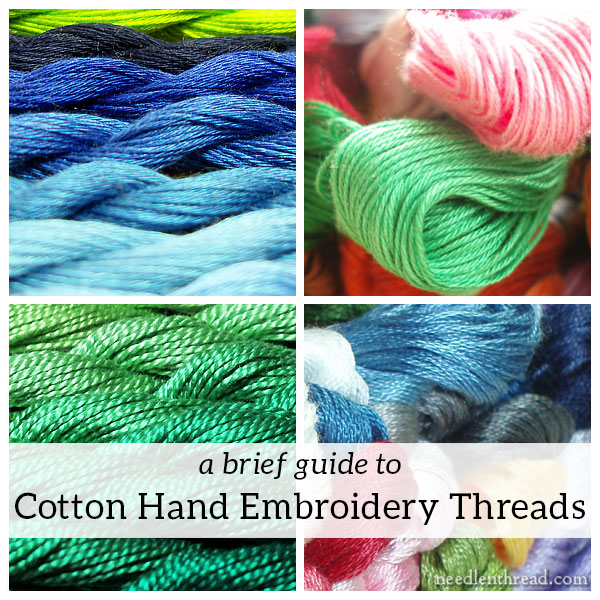
Throughout the article, I’ll provide links to other articles on Needle ‘n Thread that will give you more information on the thread. If you want to really understand the thread, how it’s used, what it can be used for, and what it looks like in relation to other threads, feel free to explore the links for more information!
Cotton embroidery floss (or “stranded cotton”) is one of the most commonly used fibers in hand embroidery. Not only is it is widely available, but it comes in a massive range of colors and is affordable.
Besides cotton floss, though, there are different types of threads made for hand embroidery. While they’re all made from the same fiber, they vary by weight (thickness) and twist.
Let’s start with the most familiar and then move on to less familiar cotton threads.
Stranded Cotton
Stranded cotton (referred to as embroidery floss here in the States) is the six-stranded cotton that most of use are very familiar with. It is a divisible thread, meaning that it can be divided into six single, fine strands, a process which is called “stripping” the floss. You can see how to separate or strip your floss here.
Here is a visual guide that demonstrates the difference in line thickness based on the numbers of strands used in a stem stitch line:
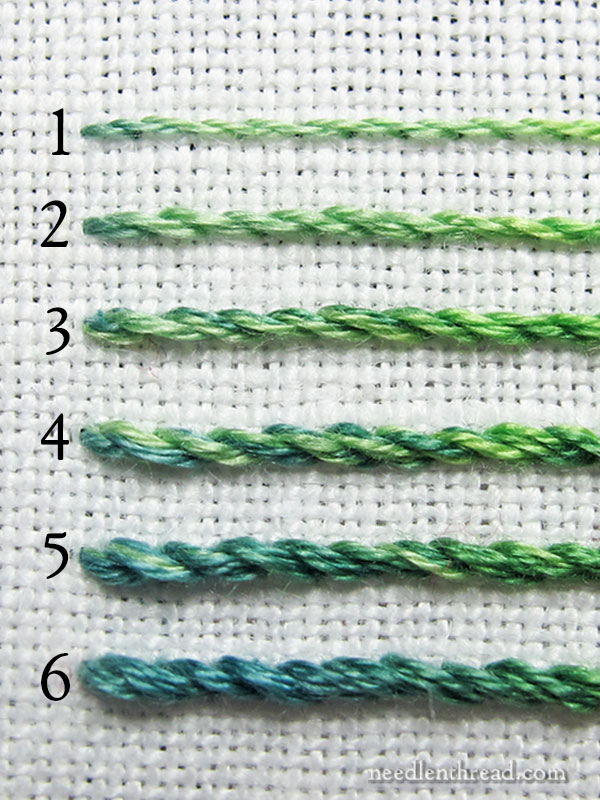
So you can see that, depending on the coverage you want or the thickness you desire for your stitches, you can use a single strand, two strands, three, or more in the needle at one time.
Common, trusted brands include DMC and Anchor, but there are other brands out there, too! Cosmo, for example, is a stranded cotton from Japan.
Many thread companies produce their own specialty dyed versions of stranded cotton, too. House of Embroidery, Weeks Dye Works, and Valdani are some examples of such companies. And then, there are many individual dyers out there who work with stranded cotton, too – like Lorraine at Colour Complements.
Perle Cotton
Perle (or Pearl) Cotton is a non-divisible embroidery or needlework thread, with a tight twist that creates a kind of “bumpy” look to the thread. Because it is non-divisible, it is used straight off the skein or ball as a single thread.
Trusted common brands include DMC and Anchor, but, like stranded, it is also available through other companies that dye their own special versions.
Perle cotton comes in different weights, from heavy to fine: #3, #5, #8, and #12. Here’s a visual guide to what they look like in relation to each other:
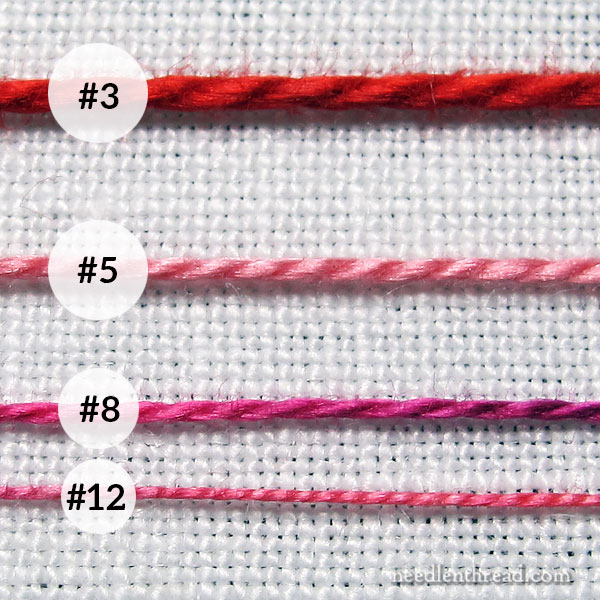
Perle cotton can be used for surface embroidery, especially when desiring a bit of texture in your stitching. It’s great for seam treatments in crazy quilting, and #5 is often favored for canvas work.
I like to use #3, #5 and #8 perle cotton when teaching children to embroider, because the thread is easy for them to handle and they don’t have to worry about separating it.
Floche
Floche is a softly twisted, fine, non-divisible embroidery thread. It is put up in a large hank, rather than a small skein. The photo below shows the difference in size between a hank of floche and a skein of regular stranded cotton:
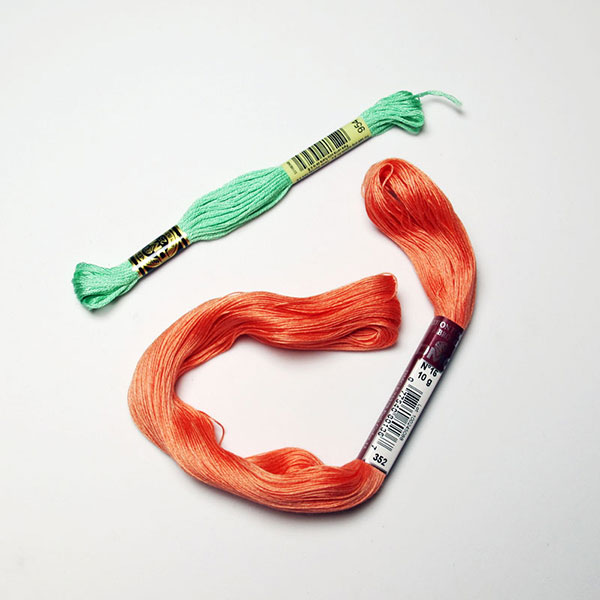
Floche is favored for embroidery on heirloom sewing, in smocking, for monogramming, and for general surface embroidery. To see examples of floche, stitched, I used it for this monogram and for this voided floral monogram.
I also used it for many of the letters in Stitch Sampler Alphabet, because…well, you just can’t beat that soft sheen:
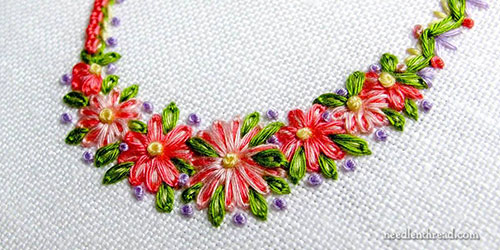
I love floche, and I’ve written about it extensively here on Needle ‘n Thread! The following articles will help you learn more about it:
Cotton Floche – What’s Not to Love?
Cotton Floche vs Coton a Broder Up Close
Long & Short Stitch with Floche
Coton a Broder
Coton a broder is sometimes called “cutwork thread” or “whitework thread” or, in some cases, “soft cotton.” It’s a beautiful soft thread with a nice sheen, though not quite as soft as floche. It’s got a tighter twist to it, compared to floche.
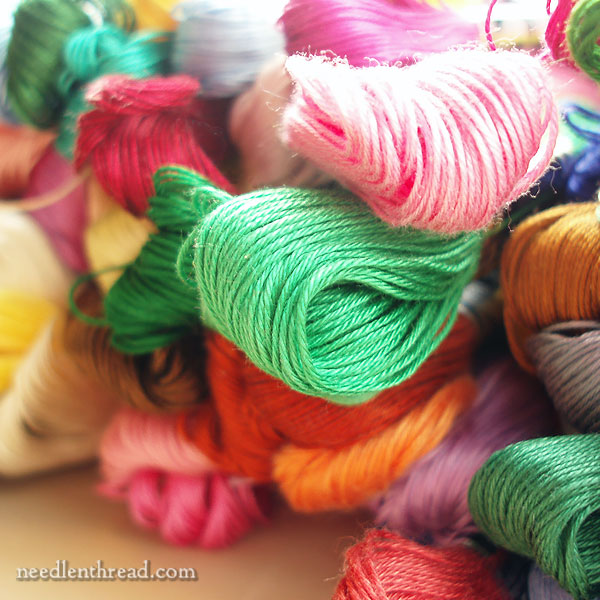
In white and ecru (suitable for cutwork, monogramming, Schwalm, and other whitework), coton a broder comes in various weights. The common range available is (from heavy to fine) size 16, 20, 25, and 30. If you’re lucky, you might find 35, 40, and even 50 available from older stock, or from more obscure suppliers in Europe, but those sizes are hard to come by these days!
Coton a broder size 25 (DMC Broder Special, Art 107) is available in a about 182 colors, and it is perfectly suitable to all kinds of surface embroidery, smocking, monogramming, and other heirloom stitchery stuff.
You can read more about coton a broder in the articles below:
Coton a Broder Questions, Floche, and Danish Flower Thread
Choosing Colors with Coton a Broder 25
Less Common Cotton Threads for Hand Embroidery
Two threads that are less-commonly known, but made specifically for hand embroidery techniques are Danish flower thread and Mountmellick embroidery thread.
Danish flower thread is a relatively soft cotton with a tighter twist than floche, that has a matte finish. It’s equivalent in weight to about two strands of DMC cotton floss, and it is available in an array of colors.
The Difference between Floche and Danish Flower Thread
Mountmellick embroidery thread is a white cotton embroidery thread with a matte finish. It’s available in four sizes: very fine, fine, medium, and heavy. It’s a firmly twisted thread. The matte finish is meant to contrast with the cotton sateen normally used as the ground fabric for Mountmellick embroidery.
Where to Find These Threads
If you’re ready to take the plunge and try a different cotton thread, you might need some resources for where to find the threads mentioned above!
Both stranded cotton and perle cotton are pretty much widely available. If you have a local needlework shop that caters to cross stitch and needlepoint, you will probably find an array of both types of cotton available there. Since most of us don’t live within driving distance of a local shop, both types of cotton are also available at chain craft and sewing stores. However, if you do have a local needlework shop (LNS) that carries these threads, consider supporting the locally owned shop first!
The more “obscure” cotton threads above are not usually available at local needlework shops, let alone craft or sewing stores, so they normally have to be found online.
In the US, Lacis carries floche, coton a broder in various weights as well as #25 in the whole color range, and Mountmellick embroidery thread. They’re not the easiest website to order from, but they sure are fun for a browse!
Vaune.com carries floche and coton a broder #25 (colors).
You can find Mountmellick thread in Canada through Tanja Berlin and in Australia through Yvette Stanton.
Danish Flower Thread is available in the UK from the Danish Handcraft Guild and in Australia from All Threads. In the US, it’s available through Ingebretsen’s in Minnesota. I’m curious about the flower thread form Ginny Thompson. I’ve not tried it, but if you have, I’d love to hear feedback!
Give it a Try!
I hope that this run-down helps you become familiar with the cotton threads available today for hand embroidery and that, if they trigger your stitchy enthusiasm, you give them a try!







Thank you Mary, this is very useful information to have and especially since I have started with Sharon’s TAST program. I especially like that you have given us some starter sources for the less common threads, the internet can be such a daunting and never ending place when searching for a particular item. Short term memory loss is not very helpful there and copious notes have to be taken. Thank goodness for copy and paste into word documents to help remember where, what and cost.
I truly enjoy reading your blogs every Monday, Wednesday, and Friday. The are entertaining, enlightening, and informative presenting in such a chatty way. Once again ~ Thank you.
Regards
Brenda
Glad you enjoy it, Brenda! Sharon’s TAST series is great fun, isn’t it?
Thank you for explaining the differences in cotton thread. I have a question; what is DMC Retors and its uses? I found a skein of it in a thrift shop, and I couldn’t resist purchasing it.
Ah, Retors is a cotton thread that’s pretty heavy, matte, and soft, and it’s not used so much in hand embroidery – it’s a bit too fuzzy-soft and tends to get more so when pulled through closely woven fabric repeatedly. You can use it, but I’d definitely use short lengths. It’s used in needlepoint, I think, more than anything else.
I appreciate the mention of Danish flower thread! I had never seen the 2008 comparison article before. I’ve used a lot of Danish flower thread, because I lived in Denmark for a while as a teen and it’s widely used there. If I get to go to Solvang (in California), the needlework shop is always a favorite stop and so I have a stash of kits, not to mention an elderly book of Christmas patterns that I love. There is a lot to say about Danish flower thread!
Dear Mary
It’s good to review cotton thread and the different threads available on the market and their specific uses in hand embroidery. My favourite cotton thread is floche and coton a broder they are really silky soft threads. The only problem with these threads is that they are hard to come by in the UK but I really like them. Thanks for sharing with us your thoughts on cotton threads and for the photos showing their different uses and for the links to your articles on them. I hope you have a great weekend.
Regards Anita Simmance
Thanks, Anita! I wish I could track down a source for Floche in the UK, so I could refer people there. So far, no luck!
Dear Mary,
I live in Belgium and I like your very specialized writings
I believe that in Europe “coton floche” is “Fil DMC broder special’, white or color size 16, 20 25, 30.
Bonjour Sabine!
The thread you mentioned is actually coton à broder, not floche, sadly. I checked the DMC website and the skeins are exactly the same as my DMC coton à broder skeins in all 4 weights.
Dear Mary
Thanks for your reply Yes it would be good to be able to buy them in the UK.
Regards Anita Simmance
I’ve not found a source for floche in the UK, but the Sew and So website has a pretty large range of all manner of threads, including coton a broder in a variety of weights and colours: https://www.sewandso.co.uk/threads
I’ve ordered different bits’n’bobs from them before and generally found them to be pretty prompt. They’re often my choice when I’m feeling in an thread-experiment mood! (Hello, Kreinik Reflective Yarn – which turned out to work really well as a bobbin thread to embellish a bag I made last year…)
Bonjour,
J’adore recevoir vos publications qui sont d’une grande qualité, mais pour les pays francophones serait-il possible de les avoir en français ?
Cordialement.
Sylvie
Bonjour, Sylvie! I would love to be able to offer my publications in French, but alas, I don’t have a translator who is familiar enough with embroidery to do the job. For the website, though, you can use Google Translate, and drop the url in. It will give you a roughly translated version.
I can understand why DMC doesn’t sell Floche in Europe.
Already asked the company long ago – no answer. All other kind of threads we can find here.
I wonder the same thing! They must have them available somewhere in Europe, though, or at least an equivalent. It’s a perfect thread for so many applications – especially monogramming and the like!
Even more frustrating can be that I’ve seen US ONSs say that, for legal reasons, they are unable to ship DMC coton threads to Europe! 🙁
I love Finca Perl’s cotton in size 16 from Colonial Thread. I actually prefer it to stranded cotton. I always have less tangling and loop knots with Finca than with stranded cotton.
Why not try the Ginny Thompson thread. In the top left corner of her site, there’s a place to click to try it free…just a couple of stamps. Then you can tell us who makes the best flower thread!
I always so appreciate your thread posts, Mary. I even find your reviews of the threads you choose to review helpful in order to evaluate those you haven’t reviewed. Your notes provide insight in what to look for when sampling some of the lesser known brands: Does the thread fuzz up? Twist? Is it colorfast? How does it spread? Your pros and cons are so instructive in learning to tune in to the qualities of threads (and fabrics too) and just help to elevate my ability to define what I might have sensed, but hadn’t necessarily defined in order to make the best choices for projects. And you have also introduced me to threads and fabrics and
brands I had never heard of. Dangerous! But, oh the sighs of delight when playing in my stash. 🙂 Thanks!
Linda
Another stranded cotton thread is Sullivans Floss which is made from Egyptian Cotton
In the UK, Sew and So seems to carry a large range of embroidery thread. Perhaps they could help Anita? Their website is https://www.sewandso.co.uk. Good luck!
I do wish floche came in smaller put ups and more colours.
Me, too! I like the color selection, though – they have a good shade range of the major colors, and a lot of nice accent colors. But wow, smaller put-ups would be great.
Couldn’t agree more. So much thread is such a daunting quantity. However, I have considered buying a skein of white and then dying parts of it to the colors and shades I would prefer using Procion dyes. When that happens, probably this summer, I’ll let you all have some feedback.
What great information. Thank you so much.
Thank you, Mary, for another clearing in the thicket of embroidery threads! It’s so easy to get lost therein.
Would that I knew how floche is named in German… I have a hunch that it has no name at all, because it’s simply not known here. Perhaps it’s an invention by DMC?
Thanks also to Teresa for the link to sewandso! I like them, but they don’t carry floche either. The shipping charges from UK to Germany are quite high, that’s why I usually prefer to order from local websites or in our local needlework shop, but I would even agree to lay out the extra costs, if only I had the chance to try this legendary floche. But alas…
Angela from the Ore Mountains
Me too MagaLuisa i search and search and nothing found
Floche DMC thread doesn’t reach Europe and couldn’t understand why,
Has the DMC Company something to say us?
And yet DMC is an European company, from France, as far as I know, isn’t it? In that case, I really wonder at their somewhat poor relation to Europe …
Cumprimentos para Portugal, Méri! 🙂
Hello Mary, I appreciate the refresher info on threads. I have used 4 kinds and Anchor is my fav in 6 stranded, floche not so much- falls apart on me too easy. When in South Australia last year I found Cosmo threads. Heaven! It looks & feels like silk. Glides thru fabrics with no trouble. Cost was quite a bit more so I`m saving them for a special project. Thanks, Barbara from Phoenix, Ariz.
Mary,
As Always your posts are full of such useful information. For anyone who is looking. I just found terrymillerdesigns (in the US) on Etsy. They sell 1/4 skeins of Floche in color packs. They have VERY limited stock left and Terry told me that Floche is no longer available retail. Haven’t confirmed that but it’s what she said.
Thanks Mary for all you do.
Hi Mary!
Lovely article. 🙂 Even though I’m well acquainted with all the main entries except pearl #3 and floche (unavailable in the UK), it’s always fun to read about thread! 🙂
I have a few thoughts to add on coton à broder: A selection of colours is available in the Anchor #25 range too, although as yet a more limited selection at only 80 shades. It’s a relatively recent addition to the range though, so who knows how it may widen in the future. Some colours in #16 are also still available in the Anchor brand and sewandso.co.uk carry the full range of available colours in the DMC #16 gauge.
‘Soft cotton’, or ‘soft embroidery cotton’ is a totally different product, much thicker and closer to tapestry wool than coton à broder. It has a good colour range in both major brands.
Correction: DMC coton à broder #16 is available in 45 of the 78 shades at Sew and So. The rest can be bought directly from DMC themselves.
Just read this! Great article! I keep meaning to pursue flower thread and this article reminded me! I get the DMC newsletter too so that’s where I’ll start. Thank you for the information, both forgotten and unknown!
Just looked up flower thread and found Ginnie Thompson brand!
Thank you for this very nice summary, Mary. I have an old pattern that calls for #12 coton a broder. Do you have any suggestions for a substitute that would be about the same weight?
hello mary
i wait with bated breath for your newsletter
the explanation for cotton threads is an eye opener
would you have a canadian address for crewel thread supplies?
i reside on the west coast of canada
and have not had any luck finding a supplier
thank you in advance…ruby wach
Wow, Ginny Thompson flower thread ~ I haven’t heard anyone talk about that thread in decades. I still have a small stash and also Ginny’s book Linen Stitches, copyright 1976. It’s a great book, spiral bound, and includes working directions several stitches. Also hem stitching. mounting and several small projects. Flower thread is nice to stitch with. It’s not as soft as floche and the color range is muted colors. Thanks Mary for the trip down memory lane. 🙂
I’m new to embroidery and this website is so full of great information! Thank you so much!
Can I just say what a fantastic resource your site is? You’re my first port of call now when I’m looking for information. Inspired by the book Slow Stitch by Claire Wellesley-Smith, a month ago I took up hand embroidery again after a good 20-year gap during which I only did plain sewing and machine embroidery. Not all of her ideas appealed, but I loved her running-stitch and kantha pieces, natural dyeing and the idea of a stitch journal. I started my ‘hearts’ journal (which you can see on my blog) with a simple running stitch but quickly realised I wanted to branch out a bit, so now I try to learn a new stitch every couple of days – I seem to be particularly drawn to chain stitches, threading and knots, and I find this hour that I claim for myself each morning very calming. I’m using vintage threads almost exclusively (my own stash is now pretty vintage anyway, since some of it is 35 years old) and have built up quite a collection, many from companies that are no longer trading. I particularly love the perlé cottons from Cartier-Bresson, Retors d’Alsace from DMC and the stranded cottons from Peri-Lusta and Cartier-Bresson. The vintage stranded cottons from DMC are quite wiry and very different from Anchor, which are quite fluffy and good for blending, but the Peri-Lusta and Cartier-Bresson are beautifully silky and result in a very clear stitch. The Retors d’Alsace is the ‘best’ thread – sews like an absolute dream – gliding through the fabric like silk, but with no snagging. Coton à broder in various weights from Wallaert Frères, DMC and MFA is also lovely to sew with – I have weights from 0 to 22 and have dyed a portion of it with natural dyes. Aside from the cotton threads, I’m disassembling damaged silk shawl fringe and dyeing it – it’s a beautiful hand-twisted perlé thread, not the easiest to sew with, but has beautiful texture, similar to some vintage rayon twist I own. I also have a box of 1920s rayon floss, of the kind used on silk shawls of the day, which is wonderfully lustrous and gleaming and well worth the trouble it takes to sew. I’m also experimenting with ordinary vintage cotton sewing thread, using six strands and conditioning it, and find it has a similar look and feel to the vintage embroidery thread. So, a steep learning curve, but I am enjoying myself.
Great post, Mary. Are there different #12 threads for crochet and embroidery? Recently I found Anchor Freccia #12 – and it was being sold as 3 ply crochet thread. I have pictures of it but I can’t post it here. No option to upload 🙂
I know DMC and Anchor both have different lines of cotton for crochet, lace making and whatnot, but I don’t know specifically what that #12 is like. DMC produces cordonette and Cebelia, which can both be used for crochet but also for lace making, cutwork, and they like. That said, perle cotton sold in balls – so #8 and #12 – could both be used for crochet without a problem. They just don’t usually come with a huge quantity on them, which makes it problematic when crocheting large things, because you’d go through the thread so fast.
Hello Mary , I,m dabbling with silk threads at the moment ..but I do have a soft spot for the Danish Flower Threads and I have quite a collection of the fine grade of Perle cotton and the beautiful DMC cotton embroidery threads . The DMC Linen threads were lovely too , not sure if they do them anymore though .
I have always used danish flower thread and love it
Until I read this article I didn’t,t know about alternative threads
Thank you so much I shall have a try with some of these in the future
Floche thread can it be used on danish thread patterns
Hi,
I was reading one of your articles about embroidery floss, and the brand I was reading about came in a flat package and you pull the thread out through an opening you make in the top of the package. I can’t find the article, and I can’t remember the brand of floss.
Can you help me?
Thank you so much,
Julie
Hi, Julie – I think you’re talking about the Madeira cotton floss? This is the article: https://needlenthread.wpengine.com/2019/02/thread-talk-madeira-cotton-embroidery-floss.html
Mary, I am 82 and my wish is that I was 12 lived next door to you and you could teach me all of the embroidery you have done through the years. I do hope everything you have created is hidden away in a library somewhere. I wish then my future generations will still have access to the MOST beautiful embroidery in the world. Thank you Mary. Love and God’s blessings, Margaret
🙂 Thank you, Margaret!!
Where does ‘soft embroidery’ cotton fit into this? (I know Anchor make it or used to. It is shown in Mary Thomas’s Stitch Dictionary, whereas floche isn’t mentioned.) Mine has no size information. It came in 10m skeins, is cotton, made in GB and has 4 plies. I assume it is non-divisible as they are twisted together. It certainly doesn’t have a sheen. It is definitely a matte finish and it is thick.
I may need a US-UK bilingual glossary – not sure.
Sounds like something similar to Retors mat 4, which is a soft cotton embroidery yarn. It can be used for embroidery, needlepoint, etc., but it’s also great for padding under other embroidery.
Thanks & update. Anchor still make it (probably not in the UK now) and DMC make something with the same name, too. I *think* it is also sold as ‘tapestry cotton’. I can’t imagine using it for embroidery on regular fabric, but it still seems to be very widely available to schools, where they presumably still use it with the kind of fabric we had. (Something like a cross between Aida and canvas – softer like Aida, but with large holes like canvas.) It’s much too thick to use on the canvas I have, but I think that’s 18 count. I can see it couched or used for padding. I wish there was a global set of terms – at least for the English-speaking world. It isn’t helpful that DMC, in particular, call their threads different things in different places!
Thank you, you’ve saved me again! I always end up coming back to your site for all sorts of clarifications 🙂
I frequently come across floss at thrift stores without labels and I’m wondering if there is an easy way to evaluate the quality before buying.
I found your post to be very informative. Thank you for sharing. I just bought a new denim shirt and I washed it. I’m wondering what you would suggest I use for embroidering on it. I’ve never done this before and I would like something easy. I thought I might decorate the placket seams on both sides and then do something with the pockets and collar. Do you have any suggestions as to what stitch to use? I’m totally open to suggestions. Thnx Mary! Victoria
Hi, Victoria – Sorry for the delay in reply to your question! It’s hard to say what stitches to use. I think your best approach is picking out a design first, if you plan to use a design. If you’re just planning to wing it, here’s an article on my “top ten” embroidery stitches: https://www.needlenthread.com/2014/10/ten-embroidery-stitches-to-know.html Those might help!
Hi Mary!
I have a quick question about the picture showing stem stitch in varies strands of 6-stranded cotton. Is it typical for the rope/twist pattern of the stitch to become less defined (if that’s the right word?) with the more strands you use? On a flower project I’m working on now, I’m trying to work a stem stitch in 6 strands (it’s a “main” stem that a bunch of little stems branch off from) and it looks so untidy compared to the smaller (1 and 2 strand) stem stitches! I’ve pulled it out a bunch of times, reworked it, checked my twist direction, read and reread your article on the 12 steps for the perfect stem stitch, etc, but to no avail!
Hmmmm…. If you’re using 6-stranded cotton, it is s-twisted no matter what, so if you are stitching from left to right, the needle must be above the working thread. If you are working from top to bottom, it is to the right of the working thread. If you are working bottom to top, it is to the left of the working thread, and if you are working from right to left, the needle should be below the working thread. So that’s just to get needle / thread orientation out of they way.
Are you stripping your floss and putting it back together, or simply cutting the piece from the skein and stitching with it, as it came off the skein? I would do the latter when stitching with all six strands.
Are your stitches large enough for that heavy of a thread? If you are making your stitches too small, they can look cramped and messy.
Are your stitches too large? If you make them too long, then they can look loose and messy, especially when working around curves.
Is your needle large enough, so that your thread is passing through the fabric smoothly?
Do you occasionally drop your needle towards the ground, so that the thread untwists? (as you stitch, the thread will naturally try to twist up on itself)
These things might help!
I’ve just got a copy of Guida al Ricamo Hedebo and am struggling to find what cotone da ricamo n. 35 is. Can you help me please?
Hi, Karen, I would try looking at lacis.com (go through their catalog online and search). They may have what you are looking for. You could also just type in DMC cotton 35 and see what comes up.
Would it be possible to use floche or Danish flower thread instead of embroidery floss in counted cross stitch? I have a project that I would like to do that could benefit from either or both of these threads, but it is a counted cross stitch, rather than surface embroidery.
Yes, you can! Keep in mind that they are heavier than one strand of floss. Floche is about equivalent in weight to 1.5 (or a little over, but not quite 2) strands of floss.
Can German thread sold by R Rocks threads be used for hand embroidery
Do you mean Gutermann threads from Red Rock Studios? These are mostly machine embroidery threads or machine sewing threads. But I do know some people who use them for hand embroidery. There’s no rule that says you can’t use them, if you want to!
so what happens if i didn’t know how to use pearle cotton and have been separating my threads? i assumed the bumpiness would relax overtime, but i’m most concerned about durability, as i’ve been using pearle to stitch into clothing. do you have any advice for how to fix it? do i have to start over?
This beginner thanks you for this basic information. I didn’t want to invest a lot of time or money in something I’m not sure I’ll do long term.